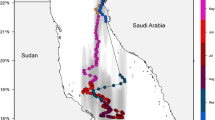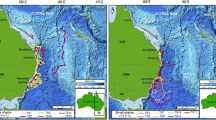Abstract
The bluntnose sixgill shark (Hexanchus griseus Bonnaterre 1788) is a large, deepwater apex predator that, in a few unique locations such as the Strait of Georgia, Canada, occupies shallow, inshore waters as juveniles. The occurrence of pregnant females in the Strait of Georgia suggests that this is an important area for parturition and juvenile rearing. Bluntnose sixgill sharks are listed under the Canadian Species at Risk Act, and an understanding of their behaviour in habitat selection during important life stages is an important component for conservation measures. We employed satellite tags to identify the daily and seasonal depth and thermal habitats of juvenile bluntnose sixgill sharks in the Strait of Georgia. Tag release and depth information suggests that juvenile bluntnose sixgill sharks within the Strait of Georgia remain there until they mature and migrate to offshore deepwaters. The dominant depth habitat utilized by the juvenile sharks in our study was deepwater (>200 m), with only occasional occupation of depths <100 m, indicating that even within coastal areas, juveniles still prefer deepwater. Overall the sharks occupied shallower depths at night than during the day with increased vertical activity in both the day and night compared to crepuscular periods. Seasonally, the sharks occupied shallower depths in the summer than in winter, but inconsistency in the temperatures with which those depths were associated suggests that their vertical behaviour is influenced by local foraging opportunities and not by thermoregulation.








Similar content being viewed by others
References
Andrews KS, Levin PS, Katz SL, Farrer D, Gallucci VF, Bargmann G (2007) Acoustic monitoring of sixgill shark movements in Puget sound: evidence for localized movement. Can J Zool 85:1136–1142
Andrews KS, Williams GD, Farrer D, Tolimieri N, Harvey CJ, Bargmann G, Levin PS (2009) Diel activity patterns of sixgill sharks, Hexanchus griseus: the ups and downs of an apex predator. Anim Behav 78:525–536
Andrews KS, Williams GD, Levin PS (2010) Seasonal and ontogenetic changes in movement patterns of sixgill sharks. PLoS One 5(9):e12549. doi:10.1371/journal.pone.0012549
Borcard D, Gillet F, Legendre P (2011) Numerical ecology with R. Springer, New York
Chapman D, Pikitch E, Babcock E, Shivji M (2007) Deep-diving and diel changes in vertical habitat use by Caribbean reef sharks Carcharhinus perezi. Mar Ecol Prog Ser 344:271–275
Comfort CM, Weng KC (2015) Vertical habitat and behaviour of the bluntnose sixgill shark in Hawaii. Deep-Sea Res II 115:116–126
Compagno L, Dando M, Fowler S (2005) Sharks of the world. University Press, Princeton
Crow GL, Lowe CG, Wetherbee BM (1996) Shark records from longline fishing programs in Hawai’i with comments on Pacific Ocean distribution. Pac Sci 50(4):382–392
DFO (Fisheries and Oceans Canada). 2011. Management Plan for the Bluntnose Sixgill Shark (Hexanchus griseus) and Tope Shark (Galeorhinus galeus) in Canada. Species at Risk Act Management Plan Series. Fisheries and Oceans Canada, Ottawa. iv + 36 pp.
Dunbrack R, Zielinski R (2003) Seasonal and diurnal activity of sixgill sharks (Hexanchus griseus) on a shallow water reef in the strait of Georgia, British Columbia. Can J Zool 81:1107–1111
Ebert DA (1986) Biological aspects of the sixgill shark, Hexanchus griseus. Copeia 1986(1):131–135
Ebert DA (2002) Some observations on the reproductive biology of the sixgill shark, Hexanchus griseus (Bonnaterre, 1788) from southern African waters. S Afr J Mar Sci 24:359–363
Ebert DA (2003) Sharks, rays and chimaeras of California. University of California Press, Berkeley
Graham RT, Roberts CM, Smart JCR (2006) Diving behaviour of whale sharks in relation to a predictable food impulse. J Royal Soc Interface 3:109–116
Hoolihan JP, Abascal J, Campana SE, De Metria G, Dewar H, Domeier ML, Howey LA, Lutcavage ME, Musyl MK (2011) Evaluating post-release behaviour modification in large pelagic fish deployed with pop-up satellite archival tags. ICES J Mar Sci 68:880–889
Hurlbert LB, Sigler MF, Lunsford CR (2006) Depth and movement behaviour of the Pacific sleeper shark in the north-east Pacific ocean. J Fish Biol 69:406–425
Jorgensen SJ, Arnoldi NS, Estess EE, Chapple TK, Rückert M, Anderson SD, Block BA (2012) PLoS One 7(10):e47819. doi:10.1371/journal.pone.0047819
Ketchen KS (1986) The spiny dogfish (Squalus acanthias) in the Northeast Pacific and a history of its utilization. Can spec pub fish Aquat Sci 88:78 p
King JR, Surry AM, Wyeth MR, Olsen N and Workman G (2013) Strait of Georgia groundfish bottom trawl survey, March 14–24, 2012. Can Tech Rep Fish Aquat Sci 3056:vii + 58 p
Loefer JK, Sedberry GR, McGovern JC (2005) Vertical movements of a shortfin mako in the western North Atlantic as determined by pop-up satellite tagging. South Nat 4(2):237–246
Mecklenburg CW, Mecklenburg TA, Thorsteinson LK (2002) Fishes of Alaska. American Fisheries Society, Bethesda
R Core Team (2012) R: a language and environment for statistical computing. R Foundation for Statistical Computing, Vienna http://www.R-project.org
Stevens JD, Bradford RW, West GJ (2010) Satellite tagging of blue sharks (Prionace glauca) and other pelagic sharks off eastern Australia: depth behaviours, temperature experience and movements. Mar Biol 157:575–591
Stone, R.P., and O’Clair, C.E. 2002. Behaviour of female Dungeness crabs, Cancer Magister, in a glacial southeast Alaska estuary: homing, brooding-site fidelity, seasonal movements, and habitat use. J Crustacean Biol 22(2): 481–492
Zuir A, Saveliev AA, Ieno EN (2014) A Beginner’s guide to generalized additive mixed models with R. Highland Statistics Ltd., Newburgh
Acknowledgements
R.P. McPhie, G.A. McFarlane, H. Brekke, M. Wyeth and the crew of the CCRV Neocaligus participated in fishing and tagging operations. H. Dewar provided logistical advice on tag programming. R. Burgess provided oceanographic data. K. Andrews provided an invaluable review of this manuscript. This project was funded under the Species at Risk Act Program of the Fisheries and Oceans Canada to J. King. The tagging of sharks was conducted in accordance with the animal care guidelines of Fisheries and Oceans Canada and the Canadian Council on Animal Care. Pte A.S. Richardson of the Royal Canadian Airforce (19 Wing Comox) found and reported the MK10-PAT tag from shark HG02.
Author information
Authors and Affiliations
Corresponding author
Electronic supplementary material
Fig. S1
Mean monthly temperature profiles from CTD casts conducted in the Strait of Georgia. Gray points are the temperature at depth recorded in the archived dataset for shark HG02. Thermocline depths estimated from the CTD casts are indicated by black points (●) (DOCX 109 kb)
Fig. S2
Mean monthly oxygen profiles from CTD casts conducted in the Strait of Georgia. Thermocline depths estimated from the CTD casts are indicated by black points (●) (DOCX 83 kb)
Table S1
(DOCX 28 kb)
Rights and permissions
About this article
Cite this article
King, J.R., Surry, A.M. Seasonal and daily movements of the bluntnose sixgill shark (Hexanchus griseus) in the strait of Georgia from satellite tag data. Environ Biol Fish 100, 1543–1559 (2017). https://doi.org/10.1007/s10641-017-0664-4
Received:
Accepted:
Published:
Issue Date:
DOI: https://doi.org/10.1007/s10641-017-0664-4




